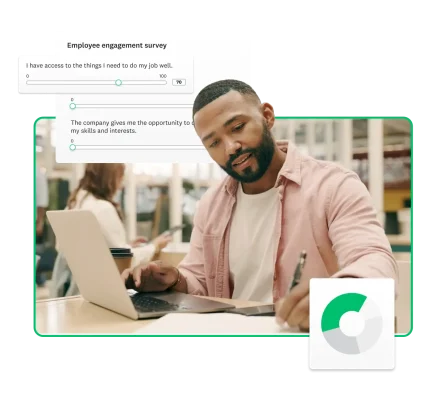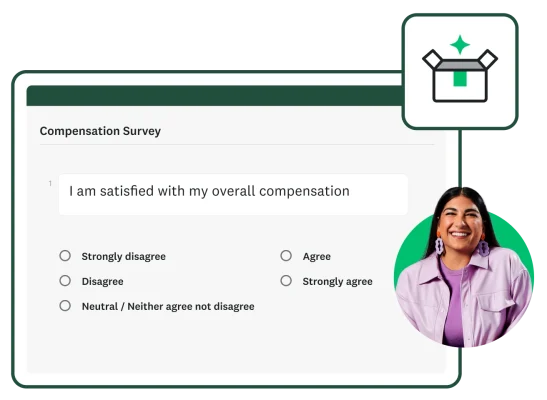What are employee engagement surveys and how to use them
Discover the power of employee engagement surveys in improving your overall employee experience at your company. Leverage surveys to enhance engagement.

When surveying HR pros, SurveyMonkey research showed that improving employee engagement is the most important reason for collecting feedback. Employee engagement is vital, directly impacting everything from retention to customer experiences.
By using employee engagement surveys, your business can quickly gather feedback, gain valuable insights, and enhance the employee experience.
In this article, we'll explore employee engagement surveys, their benefits, and best practices for effective surveys.
What are employee engagement surveys?
Organizations use employee engagement surveys to monitor employee engagement levels. The surveys can take a broad approach to engagement or focus on specific aspects of the employee experience.
Businesses can use employee engagement surveys to understand their workforce better, track employee sentiment, and identify areas for improvement.
What’s a good employee engagement survey score?
A good employee engagement survey score will depend on the specific aspects of employee engagement that a company monitors.
For example, if you asked employees to rate how engaged they are with their work, a score of 8 or above would be a good sign. However, if you asked your employees to rate their work-life balance, a score above 7.5 would be a good sign.
While industry benchmarks are available, the best approach to determining employee engagement is to look inward. By measuring your employee engagement score frequently, you can create a baseline level of engagement in your organization. Once you have established your benchmarks, you can improve your score by listening to employee feedback and integrating changes.
The best way to achieve a good employee engagement score is to aim to improve your current score month by month.
What’s a good participation percentage for engagement surveys?
When surveying your employees, it’s okay to aim for 100% participation in engagement surveys. In public-facing surveys, there could be any number of reasons why someone doesn’t respond to your survey. However, in your business, you can emphasize the importance of responding to these surveys to help boost response rates.
If your business constructs a feedback culture, your employees will see engagement surveys as an opportunity to share feedback. Emphasize the importance of feedback, and your engagement survey participation rates will increase.
Remember that you can always follow up on any surveys you’ve sent out to nudge employees who have yet to respond politely.

Benefits of employee engagement surveys
Employee engagement surveys are a great way for your staff to share their thoughts on their roles and provide feedback for improving their experience.
Here are some benefits of using employee engagement surveys in your organization:
Improved employee satisfaction
Using employee engagement surveys can increase overall employee satisfaction. Beyond rating their engagement and satisfaction, these surveys allow employees to share feedback.
By reviewing this feedback, you can identify areas for enhancing the employee experience. For example, SurveyMonkey research suggests that while 85% of workers are satisfied with their jobs, only 72% say they are well paid.
If you see a big difference in these stats in your company, it might mean you need to change your employee compensation package.
Leveraging employee feedback surveys is an excellent way to improve your organization for your employees continuously.
Higher retention rates
A high level of engagement often leads to higher employee retention rates. One example is giving feedback to your employees. Balancing giving and receiving feedback ensures your employees feel appreciated and supported.
According to SurveyMonkey research, around 63% of employees who feel recognized at work are “very unlikely” to search for a new job in the next 3-6 months.
Enhancing employee engagement makes your employees feel seen at work. This increases the chance that they’ll stay longer at your company, significantly reducing employee churn and associated costs.
Positive workplace culture
The workplace culture your business forges will directly influence your organization's overall job satisfaction and engagement rates. The best way to monitor and improve workplace culture is to go directly to your employees.
In your employee engagement surveys, you can add questions about how staff perceive the workplace culture. These questions will shed light on your current culture and help you identify areas for improvement. Over time, acting on feedback from these surveys will help create a more positive workplace culture for everyone.
Related: How to build a culture of feedback
Increased employee morale
When employees can give honest feedback that your business takes seriously, they’ll feel more content while at work. Staff engagement surveys provide the perfect forum for sharing opinions and giving constructive feedback to your business.
As you convert your employees’ feedback into actionable strategy, your employees will see you are making an effort. Sustaining these improvements over time shows your employees that you care and improves their everyday work-life experience.
Valuing, hearing, and caring for employees can improve their morale and enhance performance.
Data-driven decision-making
When you use online surveys for employee engagement feedback, you create a valuable data source for your business. By transforming this data into actionable insights, you can develop a data-driven strategy for improving employee engagement rates.
Data-driven decision-making is a powerful strategy your organization can employ. Applying this to understanding and honing your employee experiences can improve job satisfaction, employee engagement, and workplace culture.
Challenges of employee engagement surveys
While employee engagement surveys can be a powerful tool for your business, implementing them may present some challenges.
Here are some common challenges you may encounter when using employee engagement surveys.
Limited feedback
You may need to rework their format if your employee engagement surveys do not yield much data.
A common issue could be that your survey is simply too long. Employees are busy enough without having to sit down and respond to 100 questions every two weeks. Make sure that your employee engagement surveys are short and to the point.
Another potential issue is the style of your questions. Make sure to include a mix of open-ended and closed-ended questions in your survey to allow employees to respond however they want.
Finally, allow employees to remain anonymous to remain anonymous when writing their survey responses. The ability to remain anonymous will encourage honesty, benefiting your business in the long run.
Limited participation
If your business doesn’t have a feedback culture, responding to surveys about engagement may seem a little strange. Companies without a history of survey responses may have lower participation in their initial employee engagement surveys.
When you launch your employee engagement survey scheme, make sure to educate your teams on why it is essential. Demonstrating that these surveys can lead to positive change can encourage your employees to engage with them.
Survey fatigue
If your business already has an employee experience program, your teams may be used to responding to surveys. While surveys are a great tool, responding to too many at once can lead to survey fatigue.
To avoid survey fatigue in your workplace, we recommend spacing out your surveys throughout the year or quarter. Instead of making employees reply to 10 surveys for different metrics all at once, focus on one every few weeks. This reduces fatigue and provides a constant stream of new data points to add to your benchmarks.

Types of employee engagement survey questions
The types of questions you include in your survey will depend on the information you’re seeking from your employee engagement survey.
Here are some common types of survey questions you can ask to discover more about the employee experience you offer to your workers:
Organizational culture and values
This employee engagement survey aims to understand your company culture and the values your employees find important. Some typical questions in organizational culture surveys include
- Do you feel like the company has a strong workplace culture?
- To what extent do you believe our company values align with your personal values?
- On a scale of 1-10, how likely are you to recommend our company to a friend based on our culture and core values?
Job satisfaction
Job satisfaction and overall fulfillment are two important parts of employee engagement. Monitoring this area of the employee experience will help you create a better workplace for your employees with higher retention rates.
Here are some typical questions you might ask in a job satisfaction survey:
- On a scale of 1-10, how satisfied are you with your current role and responsibilities?
- What made you select the number you did in our previous question?
- To what extent do you agree with the following statement: I do work at {Company} that I am satisfied by.
Communication and feedback
The communication category of an employee survey assesses your effectiveness in engaging with your staff.
Here are some effective questions for evaluating communication in your business:
- How satisfied are you with the frequency and clarity of company communication?
- Do you feel comfortable providing feedback to your manager, and is your feedback acted upon?
- On a scale of 1-10, how effective are the communication channels you can access in our business?
Leadership and management
Leadership and management can make or break a job role. A good manager can foster an inclusive atmosphere where every team member can thrive. Asking questions related to leadership and management helps assess an employee's performance in this area.
- Does your manager provide clear expectations and support for your success?
- Do you feel recognized for your achievements and contributions?
- On a scale of 1-10, how approachable do you believe your manager is?
Team dynamics and collaboration
Assessing team dynamics from the employee's perspective helps understand how peer relationships impact the workforce. By learning more about specific teams, you can pinpoint ways to enhance collaboration.
- How well does your team collaborate and work together toward common goals?
- Do you feel a sense of belonging with your team?
- To what extent do you agree with the following statement: At {Company}, we effectively resolve any conflicts that arise.
Personal development and training
SurveyMonkey research suggests that 55% of HR leaders believe employee training is a company's most important investment to improve the overall employee experience. Surveying your staff to gauge their sense of support and growth opportunities is crucial for a thriving workforce.
- Do you have access to training and development opportunities to grow your skills? (Yes/No/Uncertain.)
- Is there a mentorship program available, and would you be interested in participating? (Yes/No/Uncertain.)
- On a scale of 1-10, how would you rank the availability of career development opportunities in our business?
Employee engagement surveys best practices
To get the most from your employee engagement surveys, structure them in a way that entices participation. Let’s touch on some best practices for employee engagement surveys:
Keep it short and concise
A short survey minimizes the chance that someone will click off before finishing, improving response rates and allowing you to collect more data.
If possible, keep your engagement survey to under five questions. If necessary, split your surveys into different categories and send them out at different times. You can measure engagement rates one month and satisfaction rates the next. You can also send pulse surveys intermittently that cover a mix of topics.
Use clear, accessible language
Don’t use complicated language in these surveys. You want to make them as easy to fill and intuitive as possible. Employees should be able to open the survey and answer all the questions without thinking.
Use clear language and simplify your questions where possible. Avoid long, conditional sentences if you can use a short, simple one.
Avoid bias
Bias in survey questions leads to bias in your final data, which could skew your results and lead to your business investing in improvements that aren’t needed.
Run your survey questions through a control group of diverse employees and solicit feedback from them. While this will mean your first survey can take longer to produce, the result of bias-free data is well worth the wait.
Consider your timing
Once Friday comes, the last thing your employees want to do at 4 pm is sit down and complete a survey. Always consider the timing of when you send these surveys out. Monday is typically a busy day in the office, while Friday is an overly relaxed one.
Send your survey in the middle of the week and away from any other events to improve response rates and enhance your data collection.
Determine the best distribution channels
Your workforce may respond better to surveys via certain channels than others. For example, some teams prefer to send out a link via an instant messaging platform, while others see higher response rates from an email from HR.
Every business is different, so it’s essential to test to find the best mediums for your business. When in doubt, emailing your online surveys is always a good place to start.
Analyze and act on your results
Collecting feedback is important, but it is only helpful if you plan to act on what your employees are telling you.
After collecting data from your staff engagement surveys, you should try to turn that feedback into actionable insights. Taking steps to create change based on feedback will show your employees you’re listening.
Improving employee experience and asking for more feedback creates a positive engagement loop, making employees feel heard.
Plan for continuous improvement
One final best practice to take into account is planning for continuous improvement. Continuous improvement means being open to changing the structure and format of the surveys you send out to best suit your workforce at any given date.
The way you interact with your employees will evolve as you continously gather feedback, refine your processes, and develop new ideas. Today's best employee engagement survey might look different in a year. The key is to plan for this adaptation and stay ready to change.
Launch effective employee engagement surveys with SurveyMonkey
Employee engagement surveys are a valuable way of gathering feedback from your staff on your employee experience. Leveraging these surveys will offer comprehensive insight into areas where your business can improve in the future.
Learn how SurveyMonkey can help you track and improve employee engagement with surveys.
Discover more resources

Attract, engage, and retain top talent with data-driven insights
Create powerful HR surveys with SurveyMonkey to gather feedback, boost engagement, and improve workplace culture. Streamline HR processes with customizable templates.

Why are surveys important in research?
Surveys are important in research because they offer a flexible and dependable method of gathering crucial data. Learn more today.

Job application surveys
Survey job applicants online to get a good understanding of your recruitment process strengths and weaknesses. Free templates and survey advice, sign up today!

HR Survey Questions: 80 Examples & Best Practices
Discover 80 HR survey questions, best practices, and tips for success to improve employee engagement.